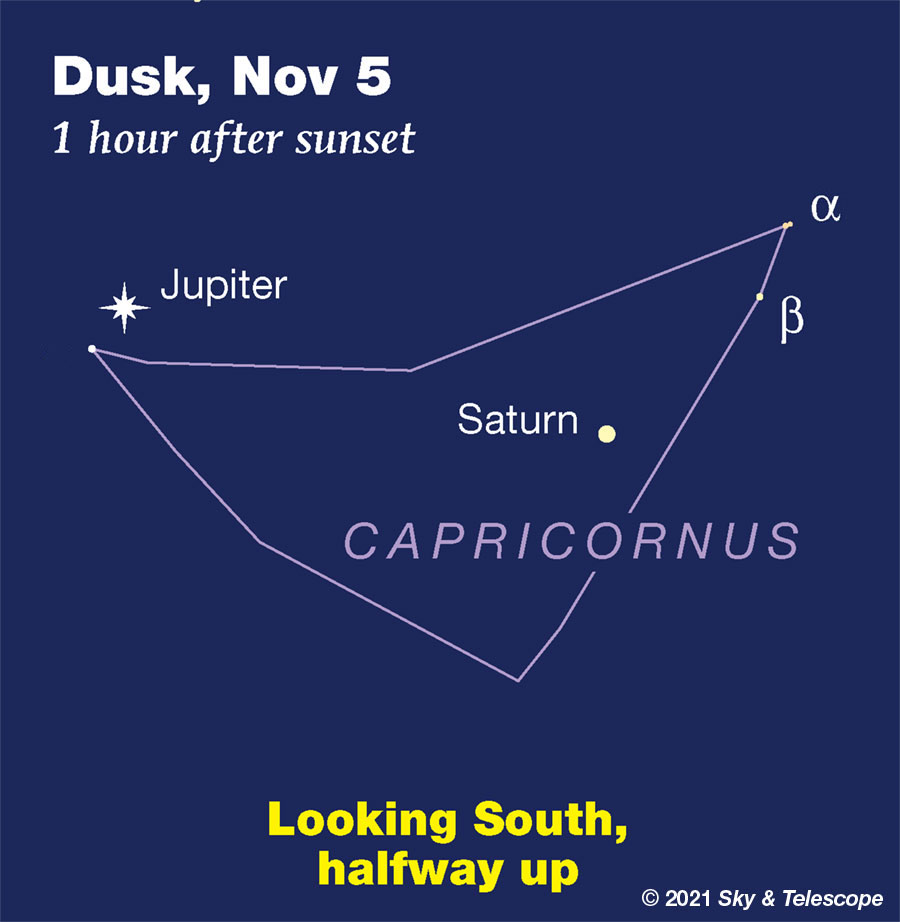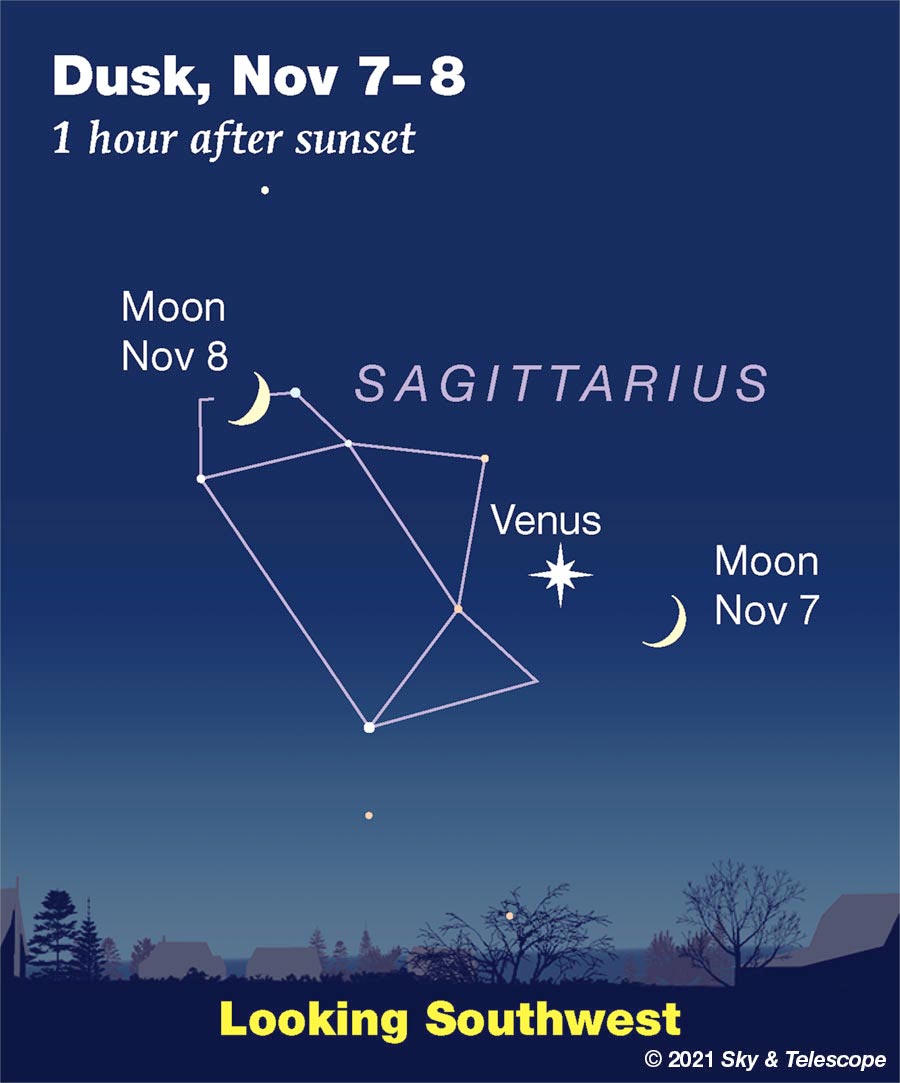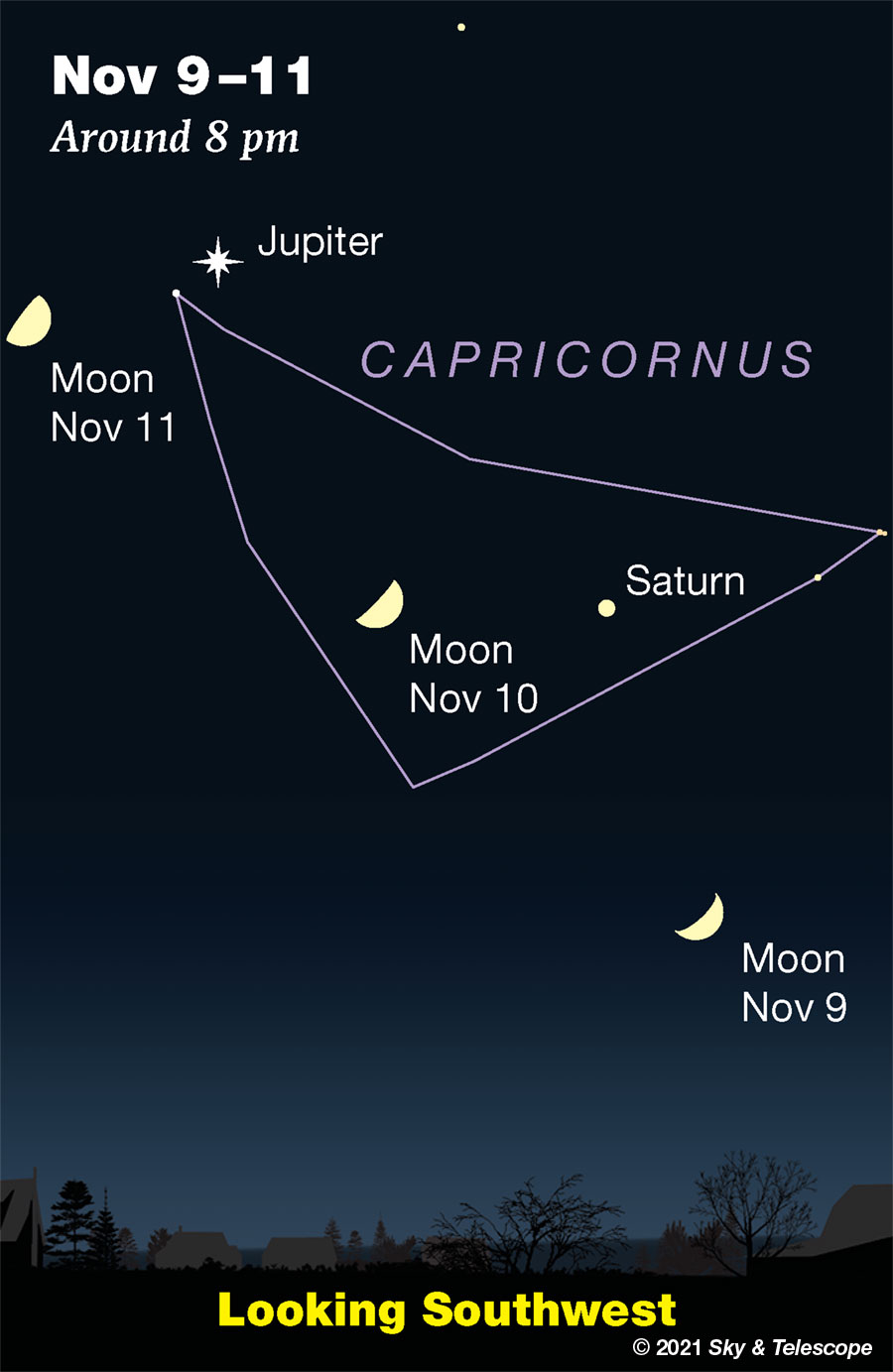Nova Cassiopeiae 2021 is still magnitude 8.3 as of November 8th, more than 7 months after it erupted. Charts and comparison stars.
FRIDAY, NOVEMBER 5
■ At dusk this week, the Jupiter-Saturn line in the southern sky tilts only mildly, as shown below. Look far to their lower right for bright Venus.
As evening progresses, Venus sets and the tilt of the giants steepens.

■ The Summer Triangle Effect. Here it is early November, but Deneb still shines near the zenith as the stars come out. And brighter Vega is still not far from the zenith, toward the west. The third star of the "Summer" Triangle, Altair, remains very high in the southwest (high upper right of Jupiter and Saturn). They seem to have stayed there for a couple months! Why have they stalled out?
What you're seeing is the result of sunset and darkness arriving earlier and earlier during autumn. Which means if you go out and starwatch soon after dark, you're doing it earlier and earlier by the clock. This counteracts the seasonal westward turning of the constellations.
Of course this "Summer Triangle effect" applies to the entire celestial sphere, not just the Summer Triangle. But the apparent stalling of that bright landmark, long after summer's end, inspired Sky & Telescope to give the effect that name many years ago and it has stuck.
Of course, as always in celestial mechanics, a deficit somewhere gets made up elsewhere. The opposite effect makes the seasonal advance of the constellations seem to speed up in early spring. The spring-sky landmarks of Virgo and Corvus seem to dash away westward from week to week almost before you know it, due to darkness falling later and later. Let's call this the "Corvus effect."
■ New Moon (exact at 5:15 p .m. Eastern Daylight Time).
SATURDAY, NOVEMBER 6
■ I don't know why I get confused trying to find the open cluster NGC 7789 in Cassiopeia, a.k.a. Caroline's Rose, with a finderscope or binoculars. I mean it's right there — a simple, short star-hop from the bright end of the Cassiopeia W. Maybe it's because the cluster is a very dim, smooth glow despite being respectably large; it's rich with stars but they're all too faint for the swarm to look speckly, and I do have light pollution. Try with the nice, clear finder chart in Matt Wedel's Binocular Highlight column in the November Sky & Telescope, page 43.
■ Daylight-saving time ends at 2 a.m. tonight for most of North America. Clocks fall back an hour.
SUNDAY, NOVEMBER 7
■ Catch Venus and the crescent Moon together in the southwest as twilight fades, as shown below. How low can you follow them down after dark?

MONDAY, NOVEMBER 8
■ Now the Moon is farther upper left of Venus, as shown above.
■ When night arrives, the Great Square of Pegasus is still balanced on its corner high in the southeast. But within two hours it turns around to lie level like a box, high in the south.
A sky landmark to remember: The west (right-hand) side of the Great Square points far down almost to 1st-magnitude Fomalhaut. The east side of the Square points down toward Beta Ceti — not as directly, and not as far.
TUESDAY, NOVEMBER 9
■ Around 10 p.m., depending on where you live, zero-magnitude Capella rises exactly as high in the northeast as zero-magnitude Vega has sunk in the west-northwest.
■ As Wednesday's dawn brightens, bring binoculars to try for Mercury and Mars in conjunction, 1° apart, very low above the eastern horizon. Look for Mars, a mere magnitude +1.6, south (lower right) of Mercury. Mercury is magnitude –0.9, ten times brighter. Your best chance might be 30 or 40 minutes before sunrise.
■ Happy 87th birthday, Carl Sagan (November 9, 1934 – December 20, 1996). If only.

WEDNESDAY, NOVEMBER 10
■ This evening, look for Jupiter upper left of the Moon and for lesser Saturn roughly half as far to the Moon's right, as shown above. Watch through the evening as this pattern moves lower toward the west-southwest, gradually rotating a bit clockwise as it goes.
THURSDAY, NOVEMBER 11
■ First-quarter Moon (exact at 7:46 a.m. EST). Jupiter shines brightly about 5° upper right of the Moon at dusk. Saturn shines more modestly to their right at dusk, and to their lower right later as shown above.
FRIDAY, NOVEMBER 12
■ The Moon now shines left of Jupiter and Saturn, forming a gentle curving arc with them.
■ The largest asteroid, 1 Ceres, is currently passing through the Hyades near Aldebaran this week. At magnitude 7.3 Ceres is faintly in binocular range. Its path is mapped in the November Sky & Telescope, page 50 (where the date ticks are for 0:00 Universal time, which falls on the evening of the previous date for North America.)
Aldebaran and the Hyades are well up in the east by 9 p.m. standard time. Robert C. Victor points out to us that on the nights of November 11-12 and 12-13 , "Ceres is passing north of the naked-eye pair Theta-1 and Theta-2 Tauri," a landmark pair of Hyads just west of Aldebaran. "These stars are 5.5 arcminutes apart, magnitudes 3.8 and 3.4. The 5.0-mag. star 75 Tauri is 24 arcminutes north of Theta-1. On November 12, Ceres passes within 9 arcminutes north of 75 Tauri. This conjunction takes place in the afternoon in North America, with Ceres moving west by 12 arcminutes per day."
SATURDAY, NOVEMBER 13
■ Look high above the Moon for the Great Square of Pegasus.
■ Vega is the brightest star high in the west on November evenings. Its little constellation Lyra extends to its left, pointing as always to Altair, the brightest star in the southwest.
Three of Lyra's stars near Vega are interesting doubles. Barely above Vega is 4th-magnitude Epsilon Lyrae, the Double-Double. Epsilon forms one corner of a roughly equilateral triangle with Vega and Zeta Lyrae. The triangle is less than 2° on a side, hardly the width of your thumb at arm's length.
Binoculars easily resolve Epsilon. And a 4-inch telescope at 100× or more should resolve each of Epsilon's wide components into a tight pair.
Zeta is also a double star for binoculars; much tougher, but plainly resolved in a telescope.
And Delta Lyrae, upper left of Zeta by a similar distance, is a much wider and easier binocular pair.
This Week's Planet Roundup
Mercury is deeper down in the sunrise glow every morning. Look for it low above the east-southeast horizon about 30 or 40 minutes before sunrise. At least it's currently bright, about magnitude –0.9. By the end of the week it'll probably be out of sight.
Don't confuse Mercury with Arcturus sparkling some 30° (three fists) to its upper left.
Venus, a brilliant magnitude –4.7, shines in southwest during and after twilight. It's now encroaching into the vastly fainter Sagittarius Teapot. Venus doesn't set now until about an hour after dark. It will continue to shine a little higher and brighter through the end of November.
Mars, a mere magnitude +1.6, is emerging deep in the sunrise in the vicinity of Mercury, which is ten times brighter at magnitude –0.9. Catch them in conjunction on the morning of November 10th, when Mars is 1° south (lower right) of Mercury. Bring binoculars.
Jupiter and Saturn continue to shine in the south during evening, 16° apart in Capricornus. Jupiter is the bright one at magnitude –2.4. Saturn, to its right or lower right, is mag +0.6.
In twilight they're just beginning to tilt. As evening advances they tilt more steeply and move westward. Saturn sets around 10 p.m. standard time, Jupiter about an hour later.
Look 23° (two fists at arm's length) lower left of Jupiter for Fomalhaut, magnitude +1.2.
Jupiter in the news: The Roots of Jupiter's Great Red Spot Run Deep.
Uranus (magnitude 5.7, in southern Aries) is well up in the east by 7 p.m. standard time. See Bob King's Uranus Queues Up for Opposition.
Neptune (magnitude 7.9, at the Aquarius-Pisces border) is already high in the southeast at nightfall.
All descriptions that relate to your horizon — including the words up, down, right, and left — are written for the world's mid-northern latitudes. Descriptions that also depend on longitude (mainly Moon positions) are for North America.
Eastern Daylight Time, EDT, is Universal Time (also called UT, UTC, or GMT) minus 4 hours. Eastern Standard Time, EST, is Universal Time minus 5 hours. Standard time begins Sunday Nov. 7th for most of North America.
Want to become a better astronomer? Learn your way around the constellations. They're the key to locating everything fainter and deeper to hunt with binoculars or a telescope.
This is an outdoor nature hobby. For an easy-to-use constellation guide covering the whole evening sky, use the big monthly map in the center of each issue of Sky & Telescope, the magazine of the American Astronomical Society.
Once you get a telescope, to put it to good use you'll need a detailed, large-scale sky atlas (set of charts). The basic standard is the Pocket Sky Atlas (in either the original or Jumbo Edition), which shows stars to magnitude 7.6.

Next up is the larger and deeper Sky Atlas 2000.0, plotting stars to magnitude 8.5; nearly three times as many. The next up, once you know your way around, are the even larger Interstellarum atlas (stars to magnitude 9.5) or Uranometria 2000.0 (stars to magnitude 9.75). And be sure to read How to Use a Star Chart with a Telescope.
You'll also want a good deep-sky guidebook, such as the big Night Sky Observer's Guide set by Kepple and Sanner.
Can a computerized telescope replace charts? Not for beginners, I don't think, and not on mounts and tripods that are less than top-quality mechanically, meaning heavy and expensive. And as Terence Dickinson and Alan Dyer say in their Backyard Astronomer's Guide, "A full appreciation of the universe cannot come without developing the skills to find things in the sky and understanding how the sky works. This knowledge comes only by spending time under the stars with star maps in hand."
![]() Audio sky tour. Out under the evening sky with your
Audio sky tour. Out under the evening sky with your
earbuds in place, listen to Kelly Beatty's monthly
podcast tour of the heavens above. It's free.
"The dangers of not thinking clearly are much greater now than ever before. It's not that there's something new in our way of thinking, it's that credulous and confused thinking can be much more lethal in ways it was never before."
— Carl Sagan, 1996
"Facts are stubborn things."
— John Adams, 1770
 6
6









Comments
misha17
November 5, 2021 at 8:45 pm
"The west (right-hand) side of the Great Square points far down almost to 1st-magnitude Fomalhaut."
If you follow a line ~North~ from the 2 stars on the western side of the Great Square, it will lead to Polaris. Because the Great Square is at a lower declination than the Pointers in the Big Dipper, it's not as obvious*. In fact, the "Pointers" in the Great Square are almost exactly 12 hrs in Right Ascension away from the Pointers in the Big Dipper: If you follow the Great Square's "Pointers" beyond Polaris, they will lead you to the Big Dipper's Pointers low along the Northern Horizon on autumn evenings.
* If you use an interactive sky chart and set it view the sky when the lead stars in the Great Square are due South (around 8:30pm PDT this week), you see them "point" to Polaris, with the Big Dipper's Pointers on the opposite side, due North, low on the horizon.
You must be logged in to post a comment.
Rod
November 7, 2021 at 12:04 pm
Good to see misha17 comments on the Great Square of Pegasus. Last night I had about 20 folks over for some Fall activities at my place, outdoor fire, roasting hot dogs, good foods and beverages 🙂 The event was to be mostly stargazing but low and mid-level clouds were a problem. Temperature about 7C so not bad and the fire felt good. From about 6:30 PM until 8:00 PM, some clearing took place, some enjoyed views of Venus, and more participated viewing Jupiter, and Saturn using my 90-mm refractor telescope operating from 71x to 129x views. Some teens with sharp eyes noticed that part of Saturn's shadow was visible on the rings. They also pointed to Vega in the NW sky and thought it was Polaris 🙂 We had a brief celestial orienteering class out in my pasture and could see Cygnus and the summer triangle as well as Polaris to the north.
You must be logged in to post a comment.
mac2night
November 8, 2021 at 4:29 am
At around 7:00pm pst on 11/07/21 look to my left as we where go west towards the west coast of ca.how a good to great view for close to hour and almost got in a hell of a car accident but i cross the yellow line the other way and did a thanks to sky gods for that because after one best moon and venus together shows and about a hour in walmart on the way back they still were cleaning up that "glad i had my head in sky " or my truck would be in the mess too!
You must be logged in to post a comment.
Rod
November 8, 2021 at 7:34 pm
Here is another report for this evening. Sunset was glorious 🙂 [Observed 1700-1800 EST/2200-2300 UT. Sunset 1659 EST/2159 UT. First Quarter Moon 11-Nov-2021 1246 UT. The star Nunki about 41 arcminute angular separation from the Moon when I viewed. Earthshine lovely and 10x50 binoculars view excellent, same for the telescope at 71x. Hercules crater area visible with the star in same FOV, terminator line, and earthshine. Venus is putting on the show with crescent phase and very bright 🙂 Venus 43 % disk illuminated and close to 29 arcsecond angular size. Jupiter, Saturn, waxing crescent Moon, and Venus were quite a show and view tonight after sunset along the ecliptic. Observing Jupiter, Europa ended a transit at 2236 UT/1736 EST. At 71x, I could see Europa close to Jupiter’s limb appear. I noticed this near 1741 EST/2241 UT. Jupiter showed many cloud bands in the telescope view. Observing Saturn at 71x, Titan and HIP101922 star distinct near Saturn’s position. Rings visible, hint of Cassini division, and tiny portion of Saturn’s shadow on the rings visible. Shortly after sunset tonight, the sky show was lovely along the ecliptic. Stellarium and Starry Night provided sky chart details. Clear skies, temperature 13C, winds NW/6 knots. Tonight, I viewed 4 moons at Jupiter and Titan at Saturn. Our Moon makes 6 moons observed tonight ]
You must be logged in to post a comment.
mary beth
November 9, 2021 at 12:14 am
Nice report Rod! I also enjoyed your comment on Sunday. Sounds like everyone had a good time and really nice that the teenagers were interested enough to notice the shadow! Glad you’ve had good weather after that period of clouds and rain. It has been lovely weather here as well. I got a glimpse of Rigel tonight. I’m really getting spoiled by seeing three planets each evening. Hopefully we will all be able to see the lunar eclipse on the 18th/19th. It’s even fun to watch it on Stellarium !
You must be logged in to post a comment.
New Jersey Eclipse Fan
November 9, 2021 at 6:00 pm
Great reading everybody's posts, as usual. I was taking groceries out of my car at 5:30pm this evening (sunset was 4:45) and stopped in my tracks to view the almost-evenly-spaced Jupiter-Moon-Venus alignment. I snapped a photo with my pedestrian iPhone and WhatsApp'd it to my wife and kids, with instructions to maximize it in order to see Saturn between the first two. What an amazing gift we have been given to witness these otherwise-mundane moments.
You must be logged in to post a comment.
You must be logged in to post a comment.